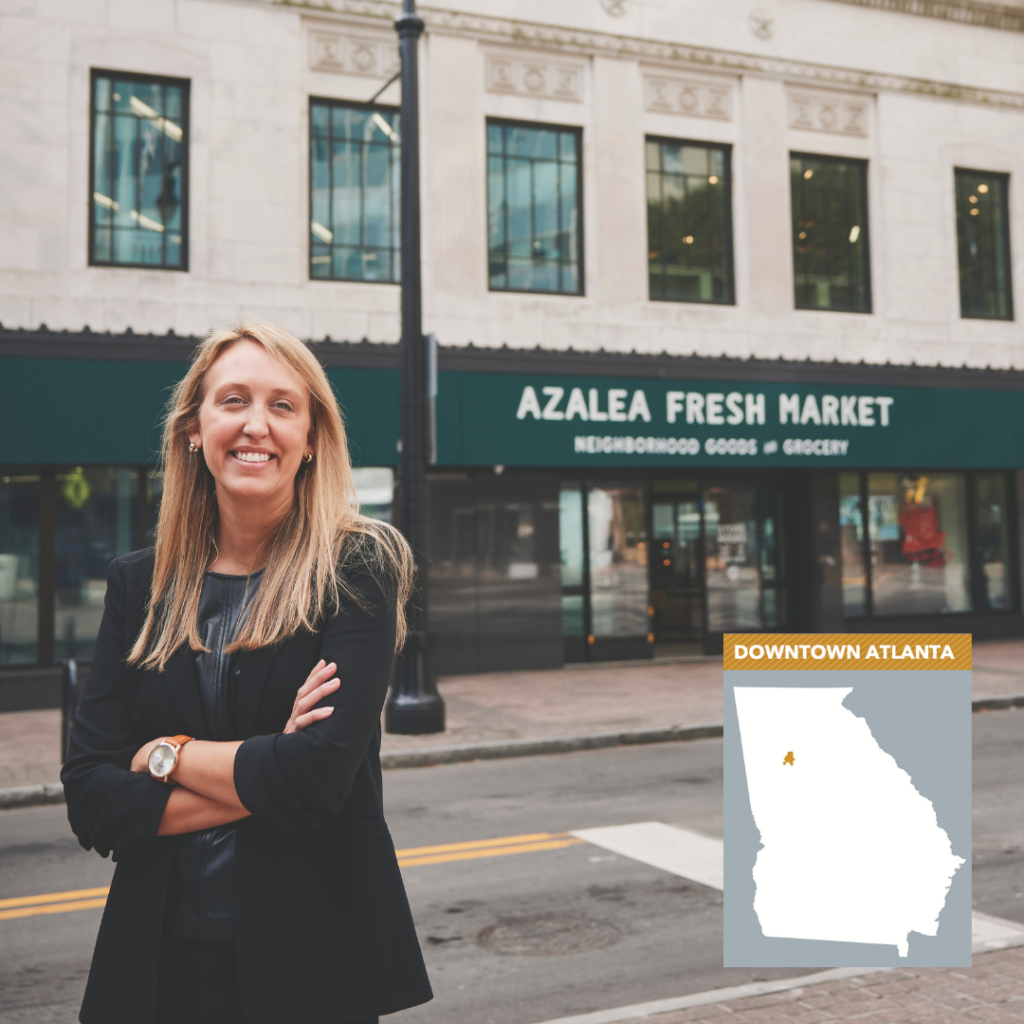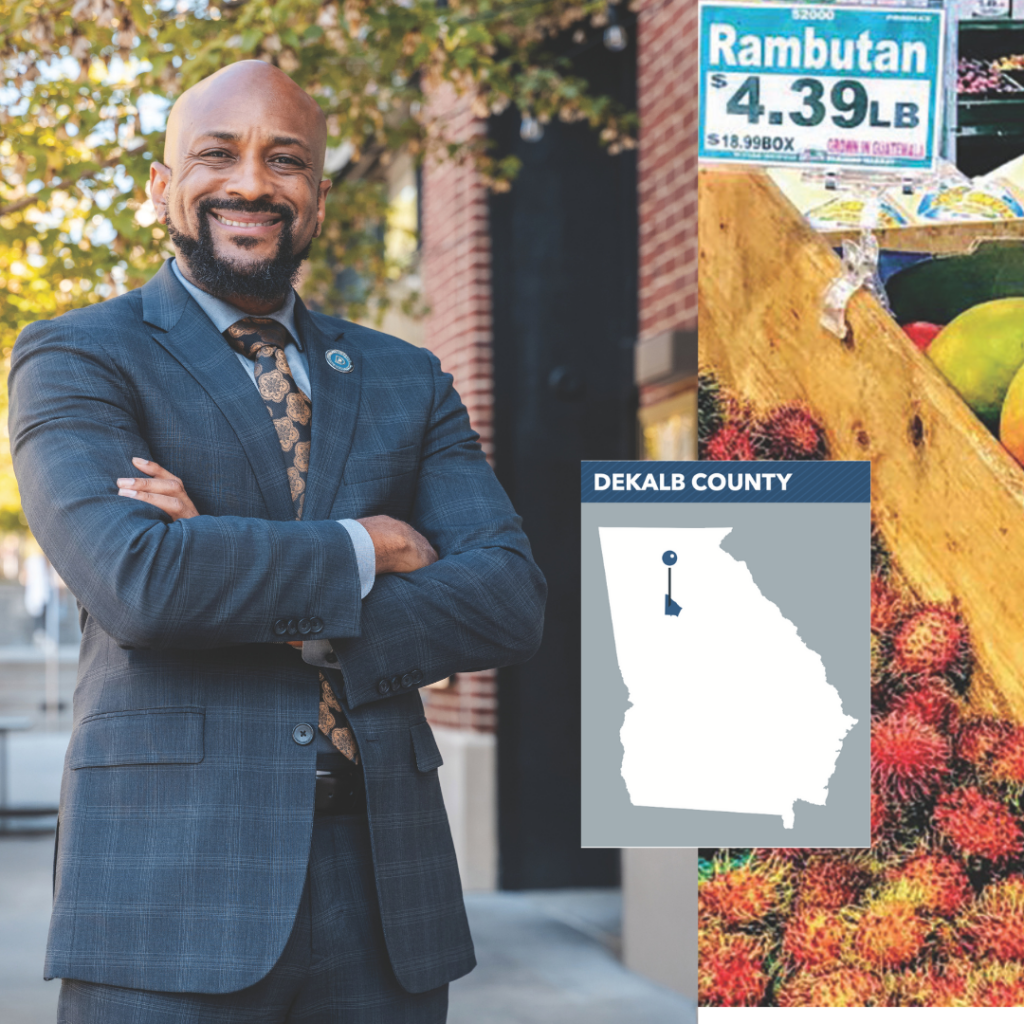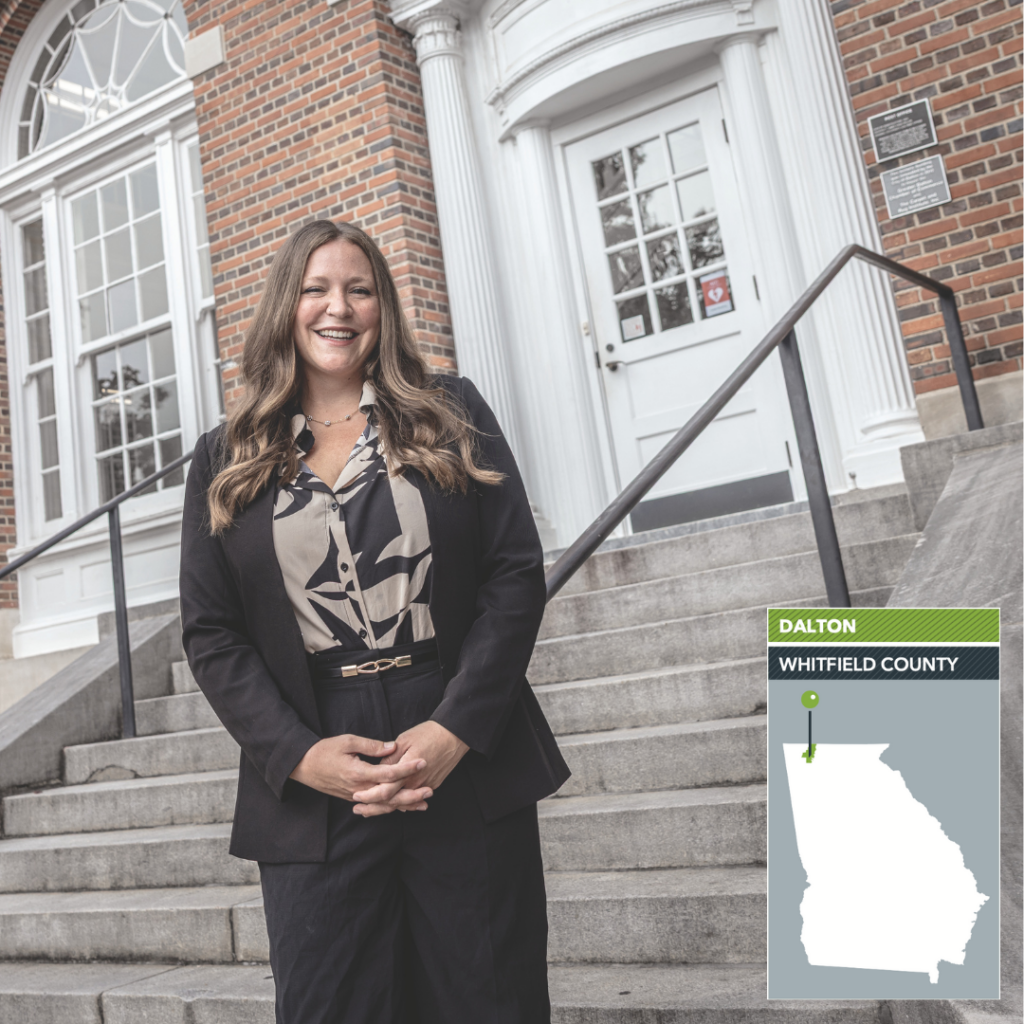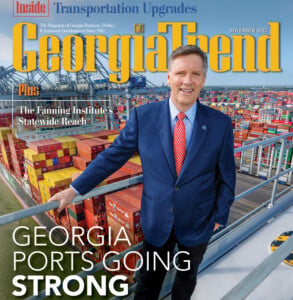Columbus | Muscogee County: Sports, Housing, Attractions
Exceeding Expectations
 Big things are happening in Columbus. From headline-making baseball news that will create a “mini-Truist Park” in the city to a major industrial expansion and the complete reimagination of a museum, Columbus’ spot on the state map is turning into a star.
Big things are happening in Columbus. From headline-making baseball news that will create a “mini-Truist Park” in the city to a major industrial expansion and the complete reimagination of a museum, Columbus’ spot on the state map is turning into a star.
Opening night for a Double-A Braves affiliate team is scheduled to be in 2025, and according to Mayor B.H. “Skip” Henderson, there’s much to be done.
“We have to have our stadium up to major-league standards and ready to play in April of 2025,” he says. “That’s a little nerve-wracking. We’ve put a bid out and we have a contractor and design team working on it all right now. They understand the importance of hitting that date, so we’re going to get it done.”

Golden Opportunity: Columbus Mayor B.H. “Skip” Henderson, at the Double-A Braves stadium under construction. | Photo credit: Nathan Leduc
It all started with a phone call from a friend in Atlanta asking if the city had a presence in baseball, Henderson recalls. Columbus didn’t have much of a presence, but certainly it had a history. Henderson says Hank Aaron, “Shoeless” Joe Jackson and even Michael Jordan during his baseball phase with the Birmingham Barons had all once played at Golden Park. The historic 3,500-seat stadium dates back to 1926 (although baseball has been played near the park since 1909). It was refurbished in 1996 and served as the Olympic venue for women’s fast pitch softball.
“We’ve had minor league teams in Columbus, back in the ’90s, but at that time there was not a lot of infrastructure in the Uptown area, so it never really got the attendance we needed,” he says. “This time around we’ve got one of the most vibrant downtowns that exists in a city our size.”
New hotels, a 12,000-square-foot food hall offering visitors numerous food and drink options, a bar and live music and Fetch Park, an off-leash dog park and bar, have all become part of the landscape in recent years.
“This is not just about baseball,” the mayor says. “If it was, I never would have brought it to council. The economic development we’re going to leverage through baseball is really exciting.”
Transformative Development
According to Henderson, what’s even more exciting is the development is happening in an area of the community that “has lagged behind.” As part of a public/private partnership, the city is paying at least $48 million to help bring the stadium up to major-league standards.

Off the Chain: Fetch Park’s off-leash dog park and bar opened its Columbus location in 2021. | Photo credit: contributed
“The entire South Commons area is all asphalt,” he says. “A multi-use facility will be constructed in the parking lot in front of the Civic Center. Very soon we’ll put out an RFP for a master planner. One of the things we’ll likely see the soonest is a hotel immediately adjacent to the ballpark. We’re also going to have a housing component – perhaps create some workforce housing, [which] is missing in every community.”
Henderson says over the years the city has spent more than $220 million in infrastructure in the South Commons area to build roads, construct a roundabout and install streetscapes, but development has been “slow to take root.”
“I’ve been around government now around 26 years and there’s never been a sustainable development initiative that has achieved any success in that specific area, and frankly, that’s what excites me,” he says. “I’m a baseball fan, but for me this isn’t about baseball, it’s about an opportunity to create transformative
development in an area that is really starved for it.
“That’s what we envision: a mini-Truist Park.”
In terms of economic impact, Henderson says the city contracted with Georgia Tech and Columbus State University (CSU) to conduct a study that concluded hundreds of jobs will be created and millions of dollars invested as a result of the project. “Conservatively, we’re looking at over 800 jobs, both direct and indirect, being created and we’re looking at $250 [million] to $400 million in private investment in that area.”
Jobs and Amenities

Strengthening the Narrative: Jerald Mitchell, president and CEO of the Greater Columbus Georgia Chamber of Commerce. | Photo credit: Number 1 Digital
Jerald Mitchell, president & CEO of the Greater Columbus Georgia Chamber of Commerce, says in addition to the economic impact and job creation, city officials expect the near-term redevelopment of nearly 180 acres surrounding Golden Park.
“Bringing a Braves minor league team to town does a couple of things,” Mitchell says. “One is it strengthens our narrative around quality of life through amenities … [And] it’ll draw people from South Georgia, Middle Georgia and Alabama.”
On top of the more than 800 jobs expected to be created by the Mississippi Braves relocation and the redevelopment of the South Commons area, in June, Pratt & Whitney announced a $206 million investment in its Columbus facility that is expected to create about 400 new jobs by the end of 2028.
“That’s the type of project we’re in pursuit of,” Mitchell says. “We’re working with other advanced manufacturers to bring similar opportunities home to Columbus.”
Pratt & Whitney’s Columbus facility supports its commercial and military programs and employs approximately 2,000. The company’s investment will go toward the purchase of new machinery, equipment and an 81,000-square-foot expansion of its Columbus Engine Center.

“Mini-Truist Park”: Rendering of the Golden Park Stadium’s $50 million makeover. | Photo credit: contributed
“What we’re seeing is the continued heartbeat of electrification and advanced manufacturing, which includes aerospace and even food production, in our economic pipeline,” Mitchell says. “Columbus has been historically good at food production and a lot of that is driven by the fact we have an enormous excess of capacity in water.”
The small business sector is also thriving and growing, according to Mitchell. Chamber membership numbers remain on an upward trajectory with roughly 130 new members a year on average over the last three years, he says.
“We continue to gain support from small businesses, and we continue to see more small businesses opening their doors and growing,” Mitchell says. “What we’re seeing is those businesses are opening in various places in the community. Right now, we’re seeing a really nice commercial district pop up in the Midland Commons area, around residential, but also where industry is, including the Pratt & Whitney expansion.”
Affordable Housing
That commercial growth is following growth in new housing starts, Mitchell says, including a 930 single-family home development.

Major Investment: Gov. Brian Kemp, left, at the groundbreaking for the expansion of Pratt & Whitney’s Columbus facility in June 2023. | Photo credit: contributed
“You can never have enough [housing], but we’re fortunate that we do continue to see new housing starts in our community as well,” he says. “We need more, and we want more, sure.”
Like a lot of communities across the state, Columbus is struggling to provide workforce housing. And efforts are also underway to increase affordable housing. U.S. Sen. Raphael Warnock recently secured $2.5 million to help create such housing, through NeighborWorks Columbus, a nonprofit that assists people with homeownership.
The funds will be used to build Providence Pointe, a 130-unit, low-income rental complex for seniors, and also nine single-family homes at Elliott’s Walk, the first new housing development in South Columbus in more than 50 years. The mayor says the city created a Tax Allocation District just off Victory Drive to help develop Elliott’s Walk. The first phase was completed in September and nearly all 20 homes were sold to moderate- and low-income families. Construction of Phase II is underway.
A private investor has also rebuilt and restored the 10-story Ralston Tower, which provides an affordable housing option for seniors.
“The Ralston downtown fell into bad repair,” Mitchell says. “It was really designed to be affordable housing for someone who had a disability, mental or physical, but a new investor has kind of put it back into use as an affordable housing option for mostly seniors – [although] they do have multiple ages. It’s filling a hole in [availability of] a quality and safe place to live.”
The key to the city’s continued growth and success is its commitment to invest in itself, Mitchell says, noting that a combined $1.1 billion has been raised through a Special Purpose Local Option Sales Tax (SPLOST) and Transportation Special Purpose Local Option Sales Tax.
“That money is being spent on new road infrastructure, supporting trail networks, parks and recreation and growth at the airport,” he says. “All of this regional infrastructure that is going to keep us moving forward.”
Unique Experiences
As home to the State Theater of Georgia and the Springer Opera House, Columbus offers one-of-a-kind assets and experiences. Adding professional sports gives the city one more unique experience that sets the Fountain City apart from other cities its size, says Peter Bowden, president and CEO of VisitColumbusGA.

Historic Restoration: The 10-story Ralston Tower was recently rebuilt as a quality place to live. | Photo credit: contributed
“We have the longest urban whitewater rafting course in the world here,” he says. “You can go zip lining across state lines, we have seven theaters in the Uptown area. Adding professional sports at this level gives us one more asset for visitors and residents to enjoy [that makes us] unlike any city of our size.”
In fiscal year 2023, 1.98 million visitors spent $381 million and supported more than 4,600 jobs, Bowden says citing a study by CSU. That resulted in tax savings of $639 per household. Those numbers were mostly up from 2022, when 2.3 million visitors spent $304 million, resulting in tax savings of $534 per household.
“If it wasn’t for that visitor spending, there would be a gap and the city would have to figure out how to fill that gap to continue to provide the same level of services,” he says.

Honoring a Legacy: The “Ma” Rainey Home is the birthplace of Gertrude Pridgett Rainey, known as the “Mother of the Blues.” | Photo contributed
Contributing to those tourism numbers was the International Canoe Federation Kayak Freestyle World Championships, which the city hosted in October. In conjunction with the kayak competitions, the city premiered the RushSouth Music Fest, a two-day festival that featured 10 bands across two stages.
“The island where the viewing point was [located] was packed with spectators,” Bowden says. “There were crowds morning, noon and night. It was a testament to popularity of the sport and what whitewater means to the city. To say the community has embraced it in a big way is a big understatement.”
Not a fan of whitewater rafting or theaters? Columbus is also home to several museums, including the Ma Rainey Home, the birthplace of Gertrude Pridgett Rainey, who was known as the “Mother of the Blues;” the National Infantry Museum and Soldier Center, outside the gates of Fort Moore (formerly Fort Benning); the National Civil War Naval Museum at Port Columbus; and the Columbus Museum.

Home Construction: Elliott’s Walk is the first new housing development in South Columbus in more than 50 years. | Photo credit: contributed
Not only is The Columbus Museum one of the largest museums in the Southeast, it was once the home of entrepreneur W.C. Bradley. When he died in 1947, his family donated his 13-acre estate to the city of Columbus to be used as a center of culture and education. Six years later, it opened as a museum, and it recently underwent a complete “reimagination,” according to Museum Director Marianne Richter.
“It is truly a complete renovation of our museum,” she says. “The museum is 89,000 square feet and the majority of the space will have been touched by the renovation.”
The public grand reopening was on May 4.
“The first exhibit [is] about the history of the museum as the home of W.C. Bradley and forward,” Richter says.
The primary motivation for the renovation was to enhance the visitor experience through open sight lines, increased natural light and improved accessibility, according to Richter. The end result is a “seamless connection between art and history galleries and the Bradley Olmsted Garden.”
New features include the redesign and reinstallation of the art and history galleries, a children’s gallery and garden near the main entrance and a grab-and-go café.
“[In] one other major, major change … we have a new and improved front entrance to the museum with pavers and seating,” she says. “Also, the berm that was in front of the museum is gone and you can actually see the building from the street. When people come in, they’re absolutely floored by how much change there has been. It really is phenomenal.”
A capital campaign that began in earnest in 2020, raised “in the neighborhood of $29 million,” Richter says, noting the museum also received another $3 million from an education SPLOST. The Muscogee County School District owns the museum building, while the Columbus Museum runs it and owns the collections.

Commemorating Veterans: The National Infantry Museum and Soldier Center is located outside the gates of Fort Moore. | Photo credit: contributed
“This is just another example of public/private partnerships that Columbus does so well,” she says. “Columbus is an amazing community and it’s incredibly philanthropic. It’s been really inspiring to see the community support for this project.
“This is the museum for our region and for visitors to the region and we really want to make this the best experience possible.”
From development to jobs to tourism, Columbus is raising the bar and exceeding expectations.
Local Flavor
Cultivating Community

Empowering Youth: Ronzell Buckner, founder and executive director of Turn Around Columbus, at George Washington Carver Victory Farm and Garden. | Photo credit: Nathan Leduc
There was a time when drug dealers sat brazenly on front doorsteps in Ronzell Buckner’s Columbus neighborhood. Not anymore. Not only did the local business owner organize and rally his neighbors to defeat the drug dealers, he created the George Washington Carver Victory Farm and Garden to offer youth in his community an alternative to drug dealing and to uplift the neighborhood, as well.
“Here at this farm, we’re doing 4.2 acres of farming; hoping to expand to 10 acres eventually,” Buckner says. “What we’re trying to do here at the farm is introduce them to the world of agriculture.”
But it’s about more than just agriculture, according to Buckner. Through agriculture, participating youth also learn math, science, entrepreneurship and how to make their community better by sharing the fruits of their labor.
Buckner is the executive director of Turn Around Columbus, a community-based organization working to empower youth with hope, opportunities and the tools to succeed through community-based education.
According to Buckner, the vegetables grown on the farm are donated to local residents who live in areas that have limited access to affordable and nutritious food. There are chickens and honeybees on the farm, too.
“A lot of people live in food deserts where their only option is [to shop at] a 7-Eleven,” he says. “If we can teach people, and [especially] young people, how to grow their own vegetables, it will be cheaper and healthier, plus they’ll be able to help their community because they can give some of the vegetables we grow to those in need.
Buckner says Turn Around Columbus, which was founded in 2001 as Turn Around Columbus Drug Fighters, has an agreement with the Muscogee County School District, which owns the land (a former baseball field) and partners with the U.S. Department of Agriculture (USDA), Fort Valley State University and local stores that donate seeds and fertilizer to help make the farm a success.
“We also have a crime prevention grant we get from the city of Columbus to help fund this project,” he says. “It’s pretty close to $3,500.”
With operations at the farm humming along, Buckner says he is now focused on creating a new initiative, one that brings volunteers into other depressed areas of the city with an offer to help create a community garden. He envisions residents taking ownership of the garden, as pride in the community is cultivated alongside the vegetables.
“We will till the land, lay the rows, plant the seeds, and somebody with the farm will work with them or a USDA rep will,” he says. “[We] want to replicate this across the city.”








